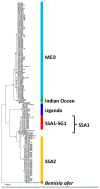Genetic Diversity of Bemisia tabaci (Gennadius) (Hemiptera: Aleyrodidae) Colonizing Sweet Potato and Cassava in South Sudan
- PMID: 31963536
- PMCID: PMC7022610
- DOI: 10.3390/insects11010058
Genetic Diversity of Bemisia tabaci (Gennadius) (Hemiptera: Aleyrodidae) Colonizing Sweet Potato and Cassava in South Sudan
Abstract
Bemisia tabaci (Gennadius) is a polyphagous, highly destructive pest that is capable of vectoring viruses in most agricultural crops. Currently, information regarding the distribution and genetic diversity of B. tabaci in South Sudan is not available. The objectives of this study were to investigate the genetic variability of B. tabaci infesting sweet potato and cassava in South Sudan. Field surveys were conducted between August 2017 and July and August 2018 in 10 locations in Juba County, Central Equatoria State, South Sudan. The sequences of mitochondrial DNA cytochrome oxidase I (mtCOI) were used to determine the phylogenetic relationships between sampled B. tabaci. Six distinct genetic groups of B. tabaci were identified, including three non-cassava haplotypes (Mediterranean (MED), Indian Ocean (IO), and Uganda) and three cassava haplotypes (Sub-Saharan Africa 1 sub-group 1 (SSA1-SG1), SSA1-SG3, and SSA2). MED predominated on sweet potato and SSA2 on cassava in all of the sampled locations. The Uganda haplotype was also widespread, occurring in five of the sampled locations. This study provides important information on the diversity of B. tabaci species in South Sudan. A comprehensive assessment of the genetic diversity, geographical distribution, population dynamics, and host range of B. tabaci species in South Sudan is vital for its effective management.
Keywords: Bemisia tabaci; distribution; genetic diversity; haplotype.
Conflict of interest statement
The authors declare no conflict of interest.
Figures


Similar articles
-
Genetic diversity of Bemisia tabaci species colonizing cassava in Central African Republic characterized by analysis of cytochrome c oxidase subunit I.PLoS One. 2017 Aug 15;12(8):e0182749. doi: 10.1371/journal.pone.0182749. eCollection 2017. PLoS One. 2017. PMID: 28813463 Free PMC article.
-
Distribution and Molecular Diversity of Whitefly Species Colonizing Cassava in Kenya.Insects. 2021 Sep 27;12(10):875. doi: 10.3390/insects12100875. Insects. 2021. PMID: 34680644 Free PMC article.
-
Molecular Diversity and Distribution of Whiteflies (Bemisia tabaci) in Cassava Fields Across South West and North Central, Nigeria.Insects. 2024 Nov 20;15(11):906. doi: 10.3390/insects15110906. Insects. 2024. PMID: 39590505 Free PMC article.
-
Tropical Whitefly IPM Project.Adv Virus Res. 2007;69:249-311. doi: 10.1016/S0065-3527(06)69006-4. Adv Virus Res. 2007. PMID: 17222696 Review.
-
Cassava whitefly, Bemisia tabaci (Gennadius) (Hemiptera: Aleyrodidae) in East African farming landscapes: a review of the factors determining abundance.Bull Entomol Res. 2018 Oct;108(5):565-582. doi: 10.1017/S0007485318000032. Epub 2018 Feb 13. Bull Entomol Res. 2018. PMID: 29433589 Free PMC article. Review.
Cited by
-
Genetic Diversity of Whiteflies Colonizing Crops and Their Associated Endosymbionts in Three Agroecological Zones of Cameroon.Insects. 2024 Aug 30;15(9):657. doi: 10.3390/insects15090657. Insects. 2024. PMID: 39336625 Free PMC article.
-
Is High Whitefly Abundance on Cassava in Sub-Saharan Africa Driven by Biological Traits of a Specific, Cryptic Bemisia tabaci Species?Insects. 2021 Mar 20;12(3):260. doi: 10.3390/insects12030260. Insects. 2021. PMID: 33804645 Free PMC article.
-
The Costs and Benefits of Two Secondary Symbionts in a Whitefly Host Shape Their Differential Prevalence in the Field.Front Microbiol. 2021 Sep 30;12:739521. doi: 10.3389/fmicb.2021.739521. eCollection 2021. Front Microbiol. 2021. PMID: 34659172 Free PMC article.
-
Occurrence and Distribution of Major Cassava Pests and Diseases in Cultivated Cassava Varieties in Western Kenya.Viruses. 2024 Sep 15;16(9):1469. doi: 10.3390/v16091469. Viruses. 2024. PMID: 39339946 Free PMC article.
-
Epidemiological Analysis of Cassava Mosaic and Brown Streak Diseases, and Bemisia tabaci in the Comoros Islands.Viruses. 2022 Sep 30;14(10):2165. doi: 10.3390/v14102165. Viruses. 2022. PMID: 36298720 Free PMC article.
References
-
- Claessens L., Stoorvogel J.J., Antle J.M. Exante assessment of dual-purpose sweet potato in the crop–livestock system of western Kenya: A minimum-data approach. Agric. Syst. 2009;99:13–22. doi: 10.1016/j.agsy.2008.09.002. - DOI
-
- Hillocks R.J., Thresh J., Bellotti A.E., editors. Cassava: Biology, Production and Utilization. CABI; Wallingford, UK: 2002.
-
- Jarvis A., Ramirez-Villegas J., Campo B.V.H., Navarro-Racines C. Is cassava the answer to African climate change adaptation? Trop. Plant Biol. 2012;5:9–29. doi: 10.1007/s12042-012-9096-7. - DOI
-
- Low J., Lynam J., Lemaga B., Crissman C., Barker I., Thiele G., Namanda S., Wheatley C., Andrade M. Sweetpotato in Sub-Saharan Africa. In: Loebenstein G., Thottappilly G., editors. The Sweetpotato. Springer; Dordrecht, The Netherlands: 2009. pp. 359–390.
-
- FAOSTAT Food and Agricultural Organization of the United Nations. [(accessed on 25 April 2019)];2017 Available online: http://www.fao.org/faostat/en/#data/QC.
Grants and funding
LinkOut - more resources
Full Text Sources

